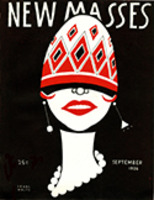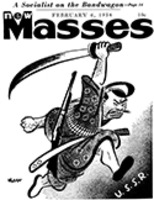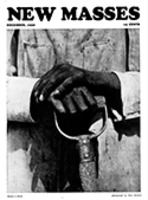New Masses History
The Magazine's Origin and Historical Context
New Masses was an American magazine that ran from 1926 to 1948 as a successor to The Liberator and The Masses. Their focus, as Helen Langa details in her article “‘At least half of the pages will consist of pictures’: New Masses and Politicized Visual Art,” was to “[promote] explicitly leftist viewpoints, but also was unusually supportive of work in the visual arts.” Heavily aligned with Marxist ideals, the magazine advocated for the working class, and labor rights, and was fervently anti-capitalist.
At its inception, the magazine was a leftist organization but still took a less militant stance. When Mike Gold became managing editor in 1927, those beliefs grew stronger, and those more Communist stances were represented. Despite Gold’s departure a few years later, in the 1930s, New Masses continued to take increasingly Marxist and Communist positions, as “images addressed labor exploitation, and American white racism, and took strongly anti-capitalist, anti business, anti imperialist, and early antifascist positions” (Langa).
The Great Depression and associated political and economic turmoil provided an important platform for the magazine to develop and generate interest amongst readers. Content included artwork in the form of lithographs, cartoons, and sketches with accompanying articles from writers, and was enhanced with high-quality ink and paper, rare for publications at the time. In 1934, they changed from a monthly to a weekly publication to support their growing numbers, following the Communist Party and publishing relevant political and cultural occurrences such as lynching, fascism in Nazi Germany and Francoist Spain, and the Moscow Trials’ (Langa). The weekly publication saw major success and in 1936, reached 100,000 readers.
In the 1940s, New Masses saw declines due to their backing of the Moscow Trials and allegiance to the Soviet Union during the height of the World War. As the original leadership changed and philosophies conflicted, popularity declined, and in 1948, they stopped publication and merged with Mainstream, another Communist magazine.
The history of New Masses and its unique ability to effectively communicate social issues, fight against capitalism, and promote workers rights demonstrated an important legacy for art and history of the era. By analyzing the work of contributors like Langston Hughes, Diego Rivera, John Dos Passos, and Rockwell Kent, we can gain more insight into their individual politics and the dynamic and unique nature of New Masses.
Above, are three covers featured in New Masses, each featuring key highlights and characteristics of the magazine. The first and second images feature covers from the magazine’s inaugural year, making use of color, including no explicit political agenda. The final features a photograph by Tina Modotti, featuring a hat placed next to a hammer and sickle. Published in the beginning of the magazine’s more radical era, it is representative of the more expressive period of New Masses, directly aligned with the Communist movement in the United States.
Part of 1 Learning Collection
<p>An In-Depth Explanation of Kent and His Beliefs<...
<p>Rockwell Kent's Unique Techniques Visualized in ...
<p>A Deeper Dive into Kent's works for the <i>New M...
<p>A Deeper Dive into the Beginning and End of the ...
Created For
K-12 EducatorK-12 Student
Museum Visitor
UMMA Docent
UMMA Staff
University Faculty
University Student
Rate this Resource
AVG: 0 | Ratings: 0
& Author Notes
All Rights ReservedLast Updated
December 2, 2023 7:05 p.m.Report
Reporting Policy



